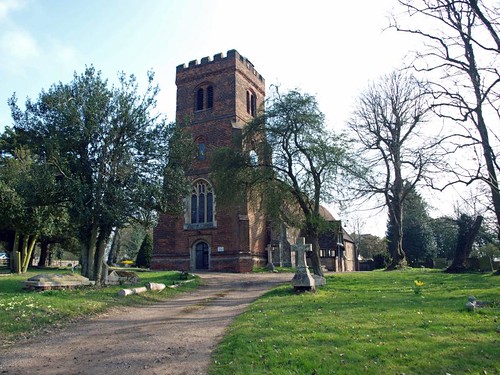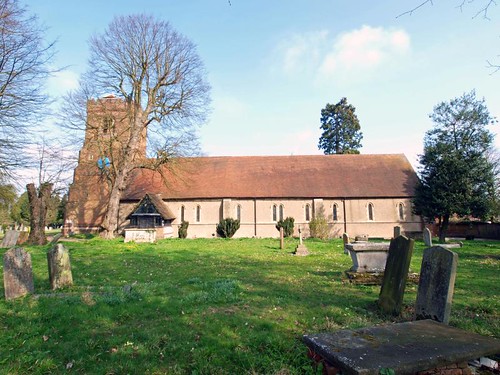Sadly, but as anticipated, all the Harlow churches were firmly locked but so too was All Saints in Epping Upland. This is a shame as this strangely attractive church, with a lengthy, but narrow, nave and a beast of a tower, is in a beautiful location and sounds interesting.
Pevsner: ALL SAINTS. The mother church of Epping which was originally the hamlet Epping Street. All Saints consists of a nave and chancel in one. Badly over-restored. There is no safe indication of a date, but the fact that the windows have all been renewed as lancets indicates a C13 origin for the church. This is corroborated by the nave Piscina (the church was perhaps lengthened to the E later) which is original and clearly E.E. Late C16 W tower of brick with diagonal buttresses and battlements. - COMMUNION RAIL. Of Roman Doric colonnettes, probably late C18. - BENCHES. A few with poppyheads in the nave. - PLATE. Cup and Paten of 1639; Paten, Flagon and Almsdish, presented 1768. - BRASS. Thomas Palmer, Professor of Common Law at Cambridge, d.1621, the figure 2 ft 6 ins. long.
EPPING UPLAND. It lies in the undulating country between Epping Town and the River Lea, and has many farms which have seen the centuries go by. The 13th century church is almost hidden by the limes and pines clustering round it with quaint tombstones 200 years old lying in their shade. The church is 120 feet long and only 21 feet wide, the absence of a chancel arch emphasising its odd shape. The 16th century tower, enriched by a corbel table, has seven bells, one attached to the outside wall.
We come into the church by a 15th century door of broad oak boards; another door, in the tower, is old enough to have a wooden lock. There is a Jacobean chair, a font cover of the same age, and a group of seats with Tudor poppyheads; but the most fascinating possession is a square poor-box with a handle, called a·collecting shovel. On the chancel wall is a brass portrait of Thomas Palmer in his robes as a Cambridge professor of Shakespeare’s day. There are also memorials to the Conyers family, who commissioned James Wyatt, the destroying architect of so many churches, to build the new Copped Hall for them. Standing in a park of 400 acres, it is built in white brick and stone, one of the biggest houses in Essex.
Flickr.
We come into the church by a 15th century door of broad oak boards; another door, in the tower, is old enough to have a wooden lock. There is a Jacobean chair, a font cover of the same age, and a group of seats with Tudor poppyheads; but the most fascinating possession is a square poor-box with a handle, called a·collecting shovel. On the chancel wall is a brass portrait of Thomas Palmer in his robes as a Cambridge professor of Shakespeare’s day. There are also memorials to the Conyers family, who commissioned James Wyatt, the destroying architect of so many churches, to build the new Copped Hall for them. Standing in a park of 400 acres, it is built in white brick and stone, one of the biggest houses in Essex.
Flickr.


No comments:
Post a Comment